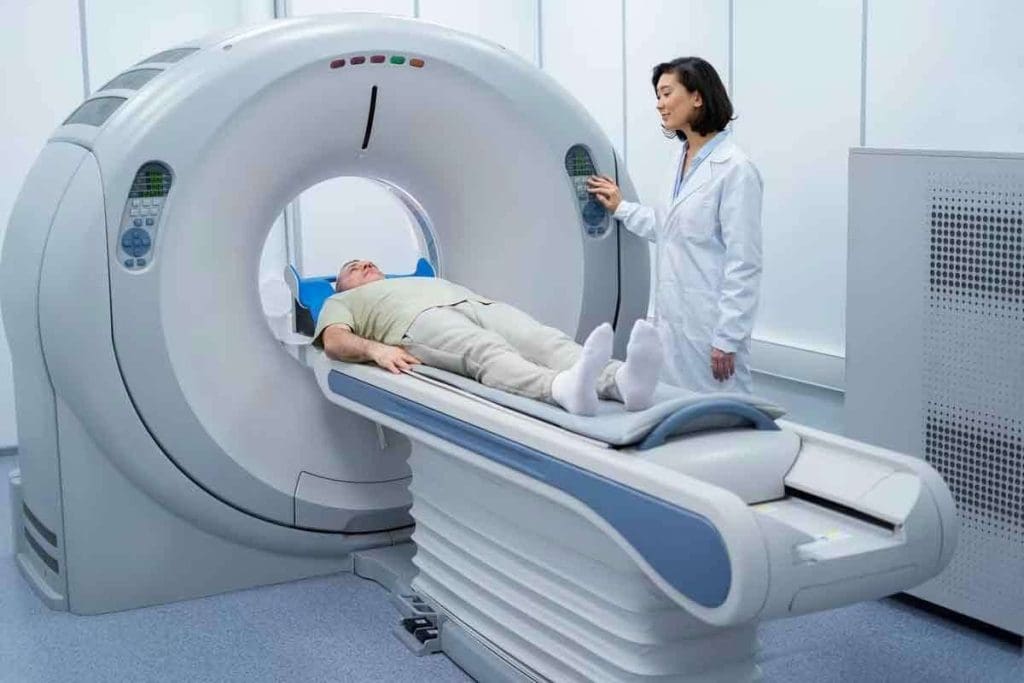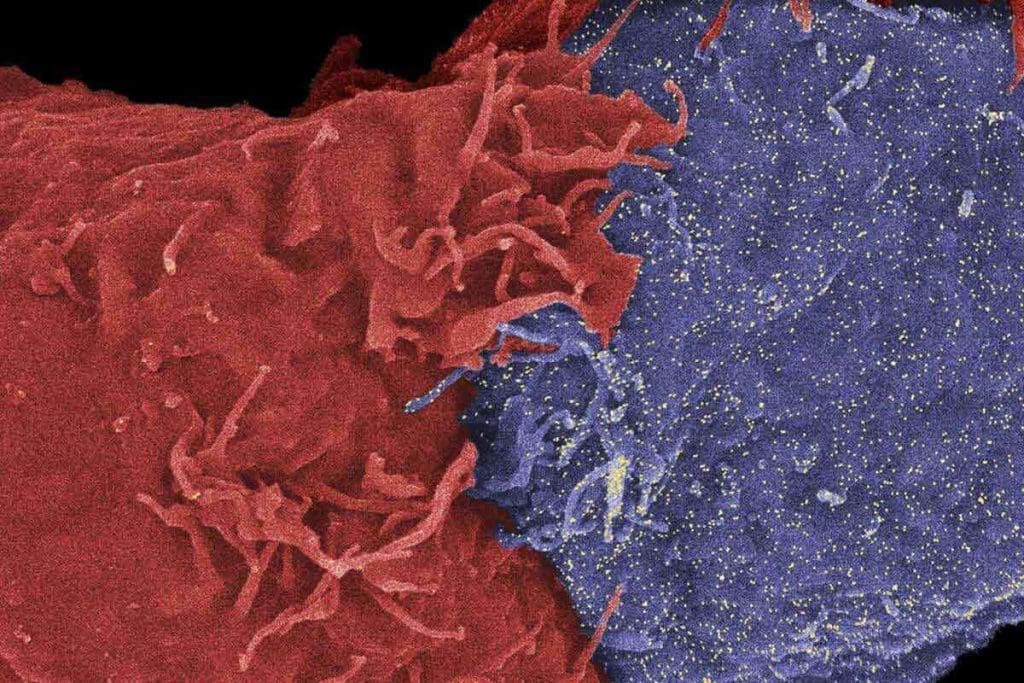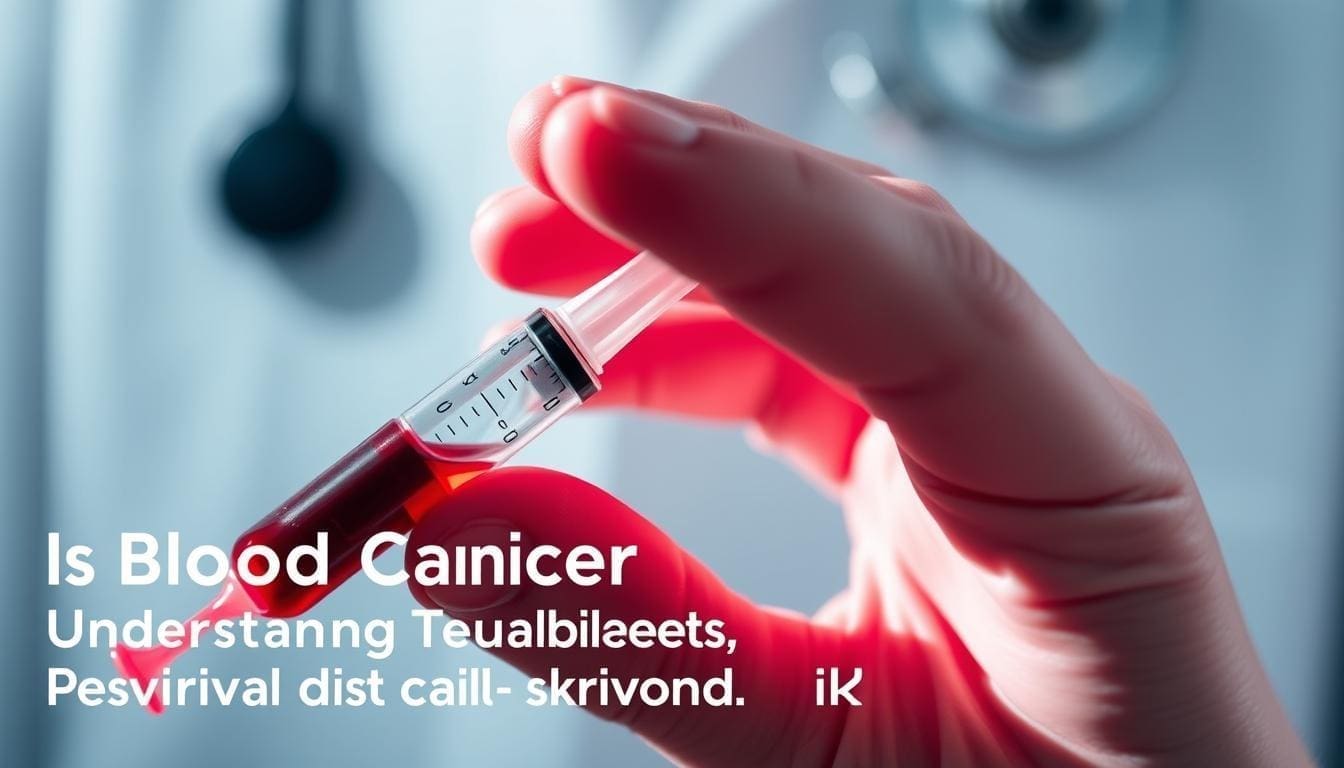Last Updated on November 27, 2025 by Bilal Hasdemir

Understanding the Benefits of Radiation Therapy
At Liv Hospital, we understand how vital effective cancer treatment is. Radiation therapy is one of the most trusted and widely used methods for treating cancer, helping millions of patients around the world. In fact, nearly 60% of cancer patients receive radiation therapy as part of their treatment plan.
The benefits of radiation are significant. It can be used alone or combined with surgery and chemotherapy to destroy cancer cells, shrink tumors, and relieve symptoms. This approach improves treatment outcomes and enhances the patient’s quality of life.
At Liv Hospital, our expert team ensures every patient receives precise, safe, and personalized radiation therapy designed for the best possible recovery.
Key Takeaways
- Radiation therapy is a leading cancer treatment used by approximately 60% of cancer patients.
- It can be used alone or in combination with other treatments like surgery and chemotherapy.
- Radiation therapy is effective in killing cancer cells and shrinking tumors.
- It improves patient outcomes and is a trusted choice for cancer care.
- LivHospital is committed to providing safe, patient-centered, and internationally benchmarked clinical standards.
Understanding Radiation Therapy for Cancer Treatment

We use radiation therapy to treat many types of cancer. It targets and kills cancer cells. This treatment uses high-energy particles or waves to harm cancer cells. It focuses on a specific area of the body.
What Is Radiation Therapy?
Radiation therapy kills or shrinks cancer cells by damaging their DNA. This stops cancer cells from growing and dividing. For more info, check out Radiation Therapy FAQs.
How Radiation Therapy Works Against Cancer Cells
Radiation therapy sends high-energy radiation to the tumor. This damages the DNA of cancer cells. It stops them from growing and eventually kills them.
The goal is to hit the tumor with the right amount of radiation. This way, it doesn’t harm the healthy tissues around it.
Types of Radiation Treatments Available
There are two main types of radiation therapy. External beam radiation therapy sends radiation from outside the body to the tumor. Internal radiation therapy, or brachytherapy, places a radioactive source inside the body near the tumor.
| Type of Radiation Therapy | Description | Benefits |
| External Beam Radiation Therapy | Radiation is directed from outside the body towards the tumor. | Non-invasive, can be used for a wide range of tumor locations. |
| Internal Radiation Therapy (Brachytherapy) | A radioactive source is placed inside the body near the tumor. | Delivers high dose directly to the tumor, minimizing damage to surrounding tissues. |
Knowing about the different types of radiation therapy is key. It helps patients make informed choices about their cancer treatment. Radiation therapy can control tumors effectively and improve quality of life.
Advantage 1: Precisely Targeted Cancer Cell Destruction

Radiation therapy is great because it targets cancer cells well. It does this without harming the healthy tissues around them. This is key in treating cancer because it helps kill the tumor while keeping the patient’s life quality good.
Advanced Targeting Technologies
We use top-notch technologies to make sure radiation hits the tumor right. These include:
- Image-guided radiation therapy (IGRT): Uses imaging like CT scans and X-rays to guide the radiation.
- Three-dimensional conformal radiation therapy (3D-CRT): Makes a 3D image of the tumor to match the radiation beams to its shape.
Conformal Radiation Techniques
Conformal radiation techniques shape the radiation dose to fit the tumor. This method helps protect healthy tissues from radiation. It reduces the chance of side effects.
Key benefits of conformal radiation techniques include:
- They make targeting tumors more precise.
- They lower the risk of damage to healthy tissues.
- They lead to better patient outcomes because they control tumors more effectively.
Intensity-Modulated Radiation Therapy (IMRT)
Intensity-Modulated Radiation Therapy (IMRT) changes the intensity of the radiation beams. This makes delivering radiation to the tumor more precise. It also helps protect healthy tissues.
IMRT is very helpful for complex tumors near important structures. It adjusts the radiation beam intensity. This way, it gives the tumor a higher dose while keeping the dose to nearby structures low.
Advantage 2: Minimizing Damage to Healthy Surrounding Tissues
Radiation therapy uses advanced tech to hit cancer cells with high accuracy. This reduces harm to healthy tissues nearby. This precision is key in cancer treatment, making therapy more effective and reducing side effects.
Protective Measures During Treatment
Radiation oncologists take many steps to protect healthy tissues. They plan and simulate to target radiation beams at the tumor. Advanced imaging techniques like MRI and CT scans help define the tumor’s shape.
Image-guided radiation therapy (IGRT) is also used. It lets doctors make adjustments in real-time if the tumor moves or changes. This ensures the treatment stays on target.
Image-Guided Radiation Therapy Benefits
IGRT brings many advantages. It improves accuracy, reduces margins around the tumor, and allows for real-time adjustments. This leads to more effective treatment with fewer side effects.
| Benefits of IGRT | Description |
| Improved Accuracy | IGRT allows for precise targeting of the tumor, reducing the risk of damage to surrounding healthy tissues. |
| Reduced Margins | With IGRT, the margins around the tumor can be reduced, minimizing the exposure of healthy tissues to radiation. |
| Adaptability | IGRT enables real-time adjustments during treatment, ensuring that the radiation delivery adapts to any changes in the tumor or patient anatomy. |
Reducing Long-Term Complications
By protecting healthy tissues, radiation therapy lowers the risk of long-term problems. This is very important for cancers in sensitive areas like the head and neck or prostate.
Using advanced techniques like IGRT and intensity-modulated radiation therapy (IMRT) helps. These methods reduce long-term side effects, improving survival and quality of life for patients.
Advantage 3: Significant Reduction in Cancer Recurrence Risks
Radiation therapy is a big help in lowering cancer comeback risks. This is a big worry for those who’ve had surgery. We’ll see how radiation therapy, used after surgery, can cut down on cancer coming back.
Post-Surgery Radiation Benefits
Radiation therapy is used after surgery to kill off any cancer cells left behind. This is key in lowering the chance of cancer coming back. It targets the area where the tumor was, helping to stop cancer from returning.
Benefits of post-surgery radiation include:
- Eliminating microscopic cancer cells that surgery might have missed
- Reducing the risk of local recurrence
- Improving overall survival rates for certain types of cancer
Statistical Evidence of Recurrence Prevention
Many studies show radiation therapy’s power in stopping cancer from coming back. For example, a study on breast cancer patients found that radiation after surgery greatly lowered the risk of cancer coming back.
| Treatment Type | Recurrence Rate |
| Surgery Alone | 20% |
| Surgery + Radiation Therapy | 5% |
The stats prove radiation therapy is a vital part of cancer treatment, helping to prevent cancer from coming back.
In short, radiation therapy is a big plus in fighting cancer recurrence, mainly when paired with surgery. The evidence and benefits show its key role in treating cancer fully.
Advantage 4: The Benefits of Radiation for Quality of Life
Radiation therapy does more than fight cancer; it boosts patients’ quality of life. It’s designed to treat cancer well and let patients live their lives as usual. This means they can keep up with their daily routines without much trouble.
Maintaining Daily Activities During Treatment
Radiation therapy lets patients keep up with their daily lives. It’s not like surgery, which can keep you in bed for weeks. Radiation therapy is done outside the hospital, so patients can work, care for their families, and do what they normally do.
Outpatient Treatment Advantages
Being treated as an outpatient has big pluses. Patients don’t have to stay in the hospital, which cuts down on infection risks. They can heal at home, saving money on hospital costs.
Psychological Benefits of Non-Invasive Options
Radiation therapy is kind to the mind, too. It’s not as scary as surgery, so patients feel less worried. Knowing they’re getting a gentle yet effective treatment helps them stay calm and positive.
Let’s look at how radiation therapy affects life quality:
| Treatment Aspect | Radiation Therapy | Surgical Intervention |
| Treatment Setting | Outpatient | Inpatient |
| Recovery Time | Minimal | Extended |
| Impact on Daily Activities | Low | High |
| Psychological Impact | Lower Anxiety | Higher Anxiety |
This table shows how radiation therapy keeps life quality high. It covers everything from where treatment happens to how it affects the mind.
Advantage 5: Tumor Shrinkage for Enhanced Surgical Outcomes
Radiation therapy is key in shrinking tumors. This helps improve surgery results for cancer patients. It’s very helpful for tumors that can’t be removed or are too big.
Neoadjuvant Radiation Therapy Explained
Neoadjuvant radiation therapy is given before the main treatment, which is usually surgery. The main goal is to shrink the tumor. This makes it easier for surgeons to operate.
Reducing tumor size helps a lot in surgery. It lets surgeons remove the tumor better. This way, they can save more tissue and organs.
Making Inoperable Tumors Operable
Neoadjuvant radiation therapy can make tumors that can’t be removed operable. Tumors too big or too close to other tissues can be shrunk for surgery.
This opens up more treatment options for patients. It also boosts their survival and recovery chances. Neoadjuvant radiation therapy can save many lives.
Preserving Organ Function Through Combined Approaches
Combining neoadjuvant radiation therapy with surgery helps keep organs working. Shrinking the tumor before surgery means less damage to tissues and organs.
This approach leads to better outcomes for patients. They are more likely to keep their bodily functions. They also face fewer long-term problems.
Advantage 6: Effective Symptom Control in Advanced Cancer
Radiation therapy is key in managing symptoms for those with advanced cancer. As cancer advances, patients face many symptoms that harm their quality of life. We’ll see how radiation therapy can help ease these symptoms, making life better for patients.
Pain Management Through Radiation
Pain is a big problem for patients with advanced cancer. Radiation therapy can target and reduce the pain by shrinking tumors. This makes patients more comfortable.
We use advanced techniques to make treatment precise and effective. This approach helps reduce pain and side effects.
Reducing Pressure from Tumors
Radiation therapy also helps reduce tumor pressure on tissues and organs. Tumors can cause discomfort and breathing issues. By shrinking tumors, we ease this pressure and improve symptoms.
Palliative Radiation Benefits
Palliative radiation therapy is made to improve life quality for advanced cancer patients. It offers:
- Effective symptom control
- Improved quality of life
- Minimal side effects
- Short treatment courses
The table below shows the benefits of palliative radiation therapy for advanced cancer patients:
| Benefit | Description | Patient Outcome |
| Effective Symptom Control | Radiation therapy targets the source of symptoms, such as tumors, to provide relief. | Improved patient comfort and reduced distress |
| Improved Quality of Life | By alleviating symptoms, radiation therapy enhances overall well-being. | Enhanced quality of life and increased functionality |
| Minimal Side Effects | Advanced radiation techniques minimize damage to healthy tissues. | Reduced risk of treatment-related complications |
Advantage 7: Potentail Curative Effects for Localized Cancers
Radiation therapy is very effective in treating localized cancers. New techniques have made it possible to target cancer cells more precisely. This reduces harm to healthy tissues nearby.
Cancer Types Most Responsive to Radiation
Some cancers respond better to radiation therapy than others. Early-stage cancers like prostate, breast, and lung cancers are good examples. When caught early, radiation can be a cure.
For example, radiation can cure early-stage prostate cancer with few side effects. It also helps breast cancer patients after surgery, lowering the chance of cancer coming back.
Success Rates in Early-Stage Treatments
Radiation therapy works well for early-stage cancers. It delivers precise radiation to the tumor, shrinking it or even removing it.
Studies show radiation therapy can match surgery’s results for some early-stage cancers. For example, SBRT is effective in treating early lung cancer with little harm.
Radiation as a Primary Treatment Option
Radiation therapy is often the first choice for localized cancers. This is true for those who can’t have surgery because of health issues or where the tumor is.
More and more, radiation therapy is being used as the main treatment for many cancers. It’s used for head and neck, esophageal, and cervical cancers, among others.
By choosing radiation therapy first, we offer patients a chance at a cure. It’s a treatment that fits their specific needs and health situation.
Advantage 8: Innovations in Radiation Therapy Improving Patient Experience
Innovations in radiation therapy are changing cancer treatment for the better. They make treatment more effective and easier for patients. These advancements are greatly improving how patients feel during treatment.
Hypofractionated Therapy: Shorter Treatment Courses
Hypofractionated therapy gives higher doses of radiation in fewer sessions. This cuts down the time needed for treatment. It’s proving to be effective for some cancers, making treatment easier for patients.
A study in the Journal of Clinical Oncology found hypofractionated therapy works as well as traditional methods. It also means less time in treatment. This is great for those with busy lives or far from treatment centers.
Stereotactic Body Radiation Therapy Advancements
Stereotactic body radiation therapy (SBRT) is very precise. It targets small tumors with large doses of radiation. Recent improvements have made it even more accurate and effective. It’s now a key option for early-stage cancer or oligometastatic disease.
A radiation oncologist, says SBRT is a game-changer. “It offers high local control rates with minimal side effects.”
“SBRT represents a significant advancement in radiation therapy, providing patients with a non-invasive and effective treatment option.”
Proton Therapy and Its Unique Benefits
Proton therapy uses protons to kill cancer cells, unlike X-rays. It causes less damage to healthy tissues. It also treats tumors near important structures.
| Therapy Type | Benefits | Indications |
| Hypofractionated Therapy | Shorter treatment courses, convenient for patients | Certain types of cancer, such as prostate and breast cancer |
| Stereotactic Body Radiation Therapy (SBRT) | Highly precise, effective for small tumors | Early-stage cancer, oligometastatic disease |
| Proton Therapy | Reduced damage to healthy tissues, treats tumors near critical structures | Tumors close to critical structures, pediatric cancers |
These new approaches in radiation therapy are making a big difference. They offer more effective and convenient treatments. As we keep advancing, we’ll see even more benefits for patients.
Advantage 9: Non-Invasive Alternative to Surgical Interventions
Radiation therapy is a non-invasive option for many cancer patients. It doesn’t require surgery or hospital stays. This reduces the risk of complications and lets patients keep up with their daily routines.
Benefits for Medically Inoperable Patients
Patients who can’t have surgery due to health issues or tumor locations find radiation therapy helpful. It offers a way to treat cancer effectively, even when surgery is too risky.
| Patient Condition | Surgical Risks | Radiation Therapy Benefits |
| Severe heart conditions | High risk of cardiac complications | Non-invasive, reducing cardiac stress |
| Tumors in sensitive areas | Risk of damaging surrounding tissues | Precise targeting, minimizing damage |
| Advanced age or frailty | Slow recovery, potentially more complications | Faster recovery, fewer complications |
Avoiding Surgical Risks and Recovery
Radiation therapy avoids the risks of surgery like infection and bleeding. It also skips the long and hard recovery time after surgery. This lets patients get back to their normal lives sooner.
Organ Preservation Strategies
Radiation therapy is great at keeping organs working. It targets tumors precisely, treating cancer without harming nearby tissues. This is key when surgery could damage organs or cause disfigurement.
Organ preservation is vital in cancer treatment. Radiation therapy is a key player in this. With modern tech and planning, we can hit cancer cells hard while saving healthy tissues. This improves patient outcomes and quality of life.
Advantage 10: Versatility in Combining with Other Cancer Treatments
Radiation therapy can be mixed with other treatments to make a complete plan for cancer care. This flexibility helps doctors create treatments that fit each patient’s needs. It could lead to better results.
Synergistic Effects with Chemotherapy
Combining radiation with chemotherapy can make the treatment more effective. Chemotherapy makes cancer cells more sensitive to radiation. This means the radiation can kill more cells.
Benefits of Combination Therapy:
- Enhanced tumor kill rate
- Potential reduction in treatment resistance
- Improved local control of the tumor
Enhancing Immunotherapy Responses
Radiation therapy can also boost the effects of immunotherapy. It helps the immune system work better with immunotherapy. This can lead to better patient outcomes.
Key Mechanisms:
- Release of tumor antigens
- Activation of immune cells
- Modulation of the tumor microenvironment
Multimodal Treatment Approaches
Mixing radiation therapy with surgery and systemic therapy is a complete way to fight cancer. This method treats cancer from all sides. It makes for a more effective treatment plan.
| Treatment Modality | Role in Cancer Treatment | Benefits When Combined with Radiation |
| Chemotherapy | Systemic treatment to kill cancer cells | Enhanced local control, reduced metastasis |
| Immunotherapy | Stimulates immune system to fight cancer | Improved response rates, durable responses |
| Surgery | Local removal of tumors | Reduced tumor burden, possible cure |
By mixing radiation therapy with other treatments, doctors can make plans that fit each patient’s needs. This flexibility is a big plus in fighting cancer. It brings new hope and better results for patients all over the world.
Conclusion: Weighing the Benefits of Radiation Therapy in Cancer Care
Radiation therapy is a key treatment for many cancer patients. It has many benefits, making it a vital option. By understanding its advantages, we can see how it improves patient care.
This treatment targets cancer cells, lowers recurrence risks, and boosts quality of life. It works well for many cancer types, from early to advanced stages. It can also be combined with other treatments to make it more effective.
Choosing the right treatment is important for each patient. Healthcare providers use radiation therapy’s benefits to create personalized plans. This approach leads to better health outcomes for patients.
Radiation therapy is a cornerstone in cancer care. It offers hope and healing to those fighting cancer.
FAQ
What are the advantages of radiation therapy for cancer treatment?
Radiation therapy targets cancer cells precisely. It also protects healthy tissues. This reduces the risk of cancer coming back and improves life quality.
It can make tumors smaller, making surgery easier. It also helps control symptoms in advanced cancer.
How does radiation therapy work against cancer cells?
Radiation therapy uses high-energy rays to kill or slow cancer cells. It can be given from outside the body or placed inside with brachytherapy.
What are the benefits of conformal radiation techniques?
Techniques like IMRT target tumors accurately. This reduces harm to healthy tissues. It leads to better treatment results and fewer long-term problems.
Can radiation therapy cure cancer?
Yes, for some cancers, radiation therapy can be curative. It’s often the main treatment for cancers that haven’t spread far. Its success depends on the cancer type and stage.
How does radiation therapy improve quality of life?
It lets patients keep up with daily life. It reduces hospital stays. It’s a gentle treatment that can ease pain and discomfort.
What is neoadjuvant radiation therapy, and how does it work?
Neoadjuvant radiation therapy shrinks tumors before surgery. This makes surgery easier and helps keep organs working better.
Can radiation therapy be combined with other cancer treatments?
Yes, combining radiation with chemotherapy or immunotherapy can improve results. This approach can work better together, helping patients more.
What are the benefits of proton therapy?
Proton therapy uses protons to kill cancer cells. It causes less damage to healthy tissues. It’s better for certain cancers, improving treatment results.
Is radiation therapy a non-invasive alternative to surgical interventions?
Yes, for some, radiation therapy is a safer choice than surgery. It avoids surgery’s risks and helps keep organs working. It improves life quality.
How effective is radiation therapy in controlling symptoms in advanced cancer?
Radiation therapy is good at managing symptoms in advanced cancer. It helps with pain and reduces tumor pressure. This improves life quality and eases suffering.
Will radiation therapy shrink a tumor?
Yes, radiation therapy can shrink tumors. This makes them easier to remove surgically. Neoadjuvant radiation is often used for this purpose.
What are the pros and cons of radiation treatment?
The benefits include precise targeting and protecting healthy tissues. It also improves life quality. The downsides are possible side effects and the need for careful planning.
Reference
- National Center for Biotechnology Information (NCBI). (2024). Health effects of ionizing radiation on the human body. https://pmc.ncbi.nlm.nih.gov/articles/PMC11052428/
Detailed scientific review of ionizing radiation effects on cellular and molecular levels, including acute and chronic health impacts, is critical for medical understanding and safety protocols.






